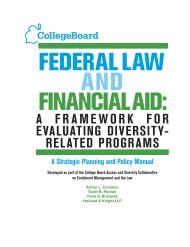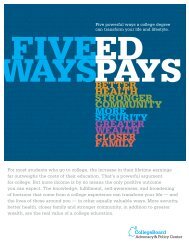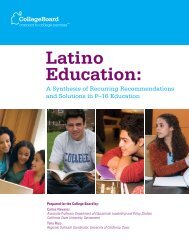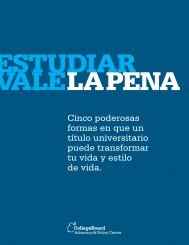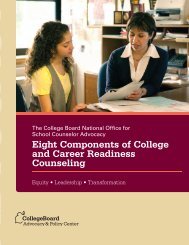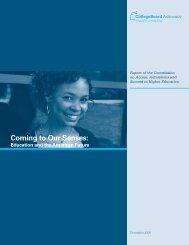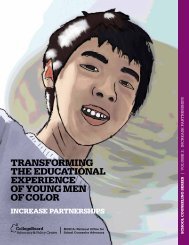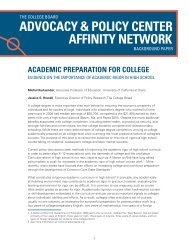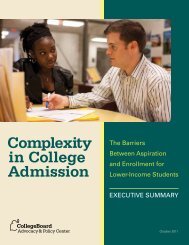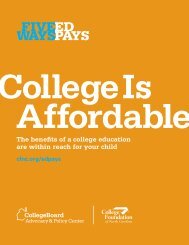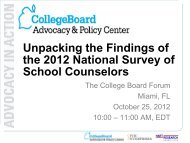Collegiate Remediation: A Review of the Causes and Consequences
Collegiate Remediation: A Review of the Causes and Consequences
Collegiate Remediation: A Review of the Causes and Consequences
You also want an ePaper? Increase the reach of your titles
YUMPU automatically turns print PDFs into web optimized ePapers that Google loves.
Trends in College <strong>Remediation</strong><br />
How pervasive is remedial course-taking at colleges <strong>and</strong> universities? Estimates from <strong>the</strong> most<br />
recent national longitudinal study <strong>of</strong> high school graduates that enter postsecondary studies<br />
suggest that nearly a quarter <strong>of</strong> all students entering four-year institutions require some<br />
remediation — some combination <strong>of</strong> reading, writing <strong>and</strong>/or math (Snyder, Tan <strong>and</strong> H<strong>of</strong>fman,<br />
2004). Rates are higher for some groups, particularly black <strong>and</strong> Hispanic students, <strong>and</strong> remedial<br />
course-taking is generally higher at two-year, open-access institutions, where many students<br />
begin <strong>the</strong>ir postsecondary study.<br />
Table 1:<br />
Rates <strong>of</strong> Remedial Course-Taking at Two-year <strong>and</strong> Four-Year Institutions for <strong>the</strong> High School<br />
Class <strong>of</strong> 2004, by Race/Ethnicity<br />
4-Year Institutions<br />
2-Year Institutions<br />
Reading Writing Math Reading Writing Math<br />
Total 16.2% 24.8% 25.8% 26.9% 29.8% 38.7%<br />
By Race/Ethnicity:<br />
White 15.1% 24.1% 23.7% 22.8% 27.2% 36.6%<br />
African American/Black 16.2% 19.9% 29.7% 34.5% 30.6% 40.5%<br />
Hispanic 22.2% 30.9% 36.2% 32.1% 34.5% 44%<br />
Asian 21.4% 33.5% 28.4% 40.1% 44.2% 46.4%<br />
Source: U.S. Department <strong>of</strong> Education, National Center for Education Statistics, Education Longitudinal Study <strong>of</strong> 2002 (ELS:<br />
2002). Estimates in this table are based on spring 2004 high school seniors who had enrolled in postsecondary education by 2006.<br />
There is strong evidence that <strong>the</strong>se national statistics grossly understate <strong>the</strong> need for remedial<br />
course-taking among college students. This is, in large part, because national studies such as<br />
<strong>the</strong> Education Longitudinal Study (ELS) rely on students’ self-reports to determine course-taking<br />
metrics. In fact, figures from large moderately selective public universities systems, such as <strong>the</strong><br />
California State University system, suggest that 60 to 65 percent <strong>of</strong> entering freshmen require<br />
some developmental course work in English, math or both (Kurlaender, Jackson <strong>and</strong> Howell,<br />
2011). Moreover, remediation is much more prevalent at community colleges than <strong>the</strong> selfreported<br />
data suggest (Perrin, 2006). Reports from <strong>the</strong> Community College Research Center<br />
indicate that it is “reasonable to conclude that two-thirds or more <strong>of</strong> community college students<br />
enter college with academic skills weak enough in at least one major subject area to threaten<br />
<strong>the</strong>ir ability to succeed in college-level courses” (Bailey, 2009).<br />
O<strong>the</strong>r college-readiness metrics based on high school preparation suggest that only one-third<br />
<strong>of</strong> graduating high school students have completed <strong>the</strong> course work <strong>and</strong> rigor necessary for<br />
success at four-year colleges <strong>and</strong> universities. Utilizing <strong>the</strong> National Assessment <strong>of</strong> Educational<br />
Progress (NAEP) 1998 study <strong>of</strong> 12th-grade students, Greene <strong>and</strong> Forster (2003), conclude that<br />
32 to 36 percent <strong>of</strong> 1998 high school graduates demonstrated college readiness. Even more<br />
troubling are <strong>the</strong> disparities in college readiness indicators by race/ethnicity.<br />
2




